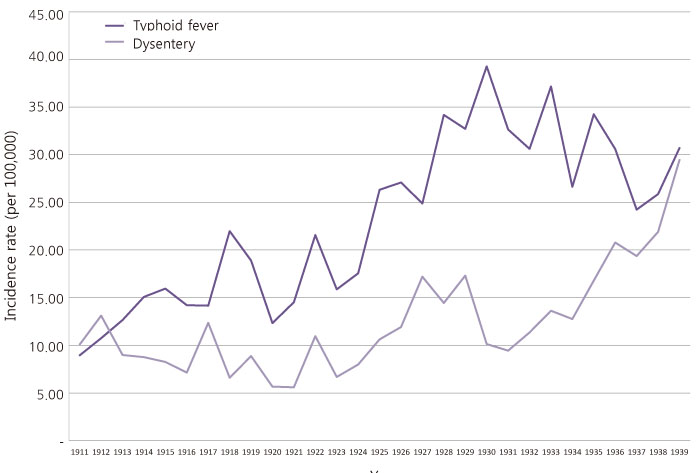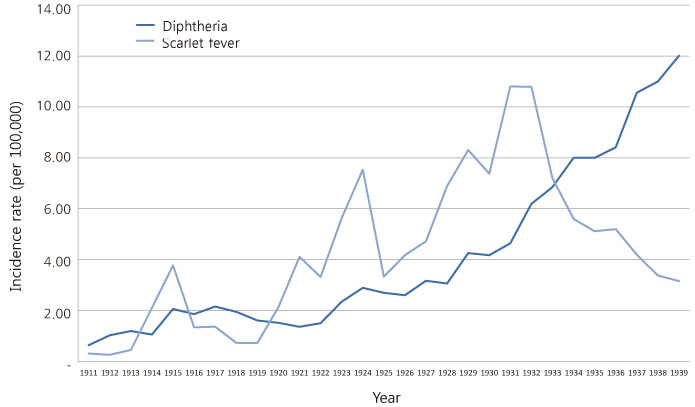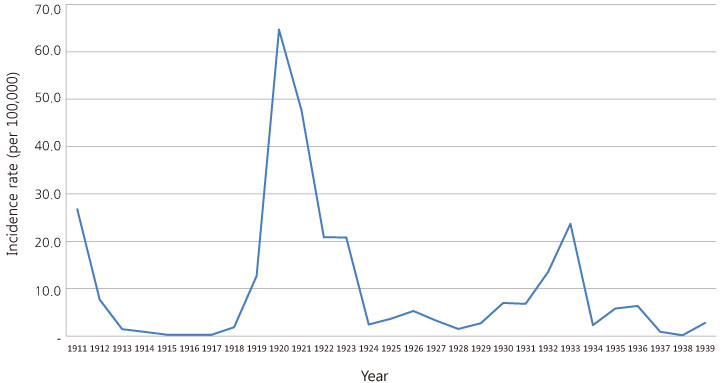Public Policy and Laws on Infectious Disease Control in Korea: Past, Present and Prospective
- Affiliations
-
- 1Department of Preventive Medicine, Korea University College of Medicine, Seoul, Korea. chun@korea.ac.kr
- KMID: 2170359
- DOI: http://doi.org/10.3947/ic.2011.43.6.474
Abstract
- The history of modern infectious disease control in Korea could be divided into 4 era by its characteristics; the Opening and Korean Empire era (1896-1910), Japanese Colonial Rule and US military government era (1910-1948), Korean government era before 2000 (1948-2000) and After 2000 (2000-present). In the Opening and Korean Empire era, the first form of communicable disease prevention act was issued in 1899, including the first 6 notifiable communicable diseases in Korea; cholera, smallpox, dysentery, diphtheria and epidemic typus. Before establishment of administrative department for infectious disease, Japanese Colonial Empire took the police power away and set the colonial sanitary police system in 1907. During the Japanese Colonial Rule, the sanitary police system was forcefully active not only to control the epidemics but also fortify the colonial governmentalism. But during the colonial era, the incidence of water-borne diseases like typhoid fever and dysentery had increased, and the respiratory diseases both diphtheria and tuberculosis also had increased. This forceful sanitary police system had influenced the communicable prevention act and health policy for over 50 years after the colonial era. In 1954 the Korean government proclaimed the communicable prevention act. Since then the government increased the number of national notifiable diseases and refined the related acts by public needs. In 2000, the communicable prevention act was fully amended to satisfy the modern public health principles not the sanitary policy rules. And the revised act named 'Infectious Diseases Control and Prevention Act' was proclaimed in 2010. The globalization, emerging and re-emerging infectious disease, climate change, change of health behavior, development information technology, unification of Korean peninsula would be the next challenges of infectious disease control and prevention in Korea.
MeSH Terms
Figure
Cited by 4 articles
-
Knowledge and Acceptability about Adult Pertussis Immunization in Korean Women of Childbearing Age
Hyun Sun Ko, Yun Seong Jo, Yeun Hee Kim, Yong-Gyu Park, Jeong Ha Wie, Juyoung Cheon, Hee Bong Moon, Young Lee, Jong Chul Shin
Yonsei Med J. 2015;56(4):1071-1078. doi: 10.3349/ymj.2015.56.4.1071.Management of Typhoid Fever – Clinical and Historical Perspectives in Korea
Mee Soo Chang, Jun Hee Woo, Sungmin Kim
Infect Chemother. 2019;51(3):330-335. doi: 10.3947/ic.2019.51.3.330.History and Epidemiology of Bacillary Dysentery in Korea: from Korean War to 2017
Hyunjoo Pai
Infect Chemother. 2020;52(1):123-131. doi: 10.3947/ic.2020.52.1.123.Elementary, Middle, and High School Health Teachers’ Countermeasures Against an Outbreak of Pandemic Diseases, Including MERS
Eunkyoung Jun, Gyuyoung Lee
J Korean Acad Community Health Nurs. 2018;29(1):65-75. doi: 10.12799/jkachn.2018.29.1.65.
Reference
-
1. Shin DW. History of modern healthcare in Korea. 1997. Seoul: Hanul Academy;120–123.2. Chun MJ. The establishment and operation of Sunhwaweon during the Japanese Colonial Rule. J Korean Mod Contemp Hist. 2011. 57:33–59.3. Korean Society of Infectious Diseases. History of infectious disease in Korea. 2009. Seoul: Koonja Publishing Co.;324–333.4. Shin DW. History of modern healthcare in Korea. 1997. Seoul: Hanul Academy;143–144.5. Jung KS. Formation, change and legacy of the colonial sanitary police in modern Korea. Soc Hist. 2011. 90:221–270.6. Lee HS. Colonial sanitary policy and Chosun society in 1910; focus on communicable diseases prevention act. Proceeding of 9th International Conference of Korean Japan Study Association. 2011. 558–561.7. Shin DW. Germ theory and criticism of colonial modernity. Crit Rev Hist. 2002. 58:341–363.8. Meng KH. One hundred years' history of public health activities in Korea. Korean J Med Hist. 1999. 8:127–136.9. Park IS. An analysis on the health administration of the Chosun government: general in Korea under the rule of Japan-with a special reference to the activities for extermination of epidemic diseases. J Public Welf Adm. 2003. 13:132–158.10. Korean Statistics before 1945, Korean statistical information service. Accessed 15 December 2011. Available at: http://kosis.kr/feature/feature_03List.jsp.11. Kim JS. Health and Diseases of Koreans. 2001. Seoul: Shin Kwang Publishing Co.;36–45.12. Whang CY, Ohr HC, Lee DH, Park KD. The amendment tendency analysis of the Korean Infectious Disease Prevention Act and a recommendation for the next amendment. Korean J Prev Med. 1998. 31:540–563.13. Chun CH. Our preventive law of communicable disease is amendable. J Korean Med Assoc. 1975. 18:181–185.14. Choi KW. Re-consideration of notifiable communicable diseases. J Korean Med Assoc. 1994. 37:12–18.15. Kim JS. Re-classification of notifiable communicable diseases in Korea. J Korean Med Assoc. 1997. 40:386–390.16. Jeong EK. Surveillance and management of notifiable communicable disease. J Korean Med Assoc. 2002. 45:750–762.
Article17. Lee DH, Park K. Revision of international health regulation and task of improving communicable disease control and quarantine system in the republic of Korea. J Korean Med Assoc. 2005. 48:784–794.
Article18. Lee EY, Lee MJ, Lee SK. A study on the reform of communicable disease control and quarantine system in compliance with the revision of the international health regulation. Korean J Med Law. 2006. 14:47–67.19. Park IK, Kim SY, Lee SG. Study on analysis of quarantine legislations and systems in australia for building an integrative quarantine system. Korean J Med Law. 2011. 19:161–187.
- Full Text Links
- Actions
-
Cited
- CITED
-
- Close
- Share
- Similar articles
-
- Acts and Public Notices on Healthcare-associated Infection Control & Prevention in the Republic of Korea
- Public health emergency preparedness and response in Korea
- Infectious disease-related laws: prevention and control measures
- Prevention and Control Strategies for Parasitic Infections in the Korea Centers for Disease Control and Prevention
- Epidemiologic Transition of Communicable Diseases in Korea: Academia's Contributions to the National Communicable Disease Prevention and Control Programs




